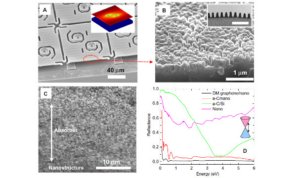Research has been published showing how graphene can be used to create a material with the highest rate of light-absorption for its weight. Researchers from the UK’s University of Surrey believe that, among other uses, the material could be used to recover energy from waste light and heat in rooms, if used on the walls.
Graphene was grown around a textured metallic surface (‘nanotexturing’). Graphene traditionally has low levels of light-absoption, but the nanotexturing increased this by about 90%; light is directed into the narrow spaces between the textured surface.
Nature was used as the inspiration for this work; specifically moths’ eyes, which have a microscopic pattern on them that channels light to the middle of the eye, and also eliminates reflections (Sharp and Samsung have both shown TVs with anti-reflective ‘moth eye’ filters in the past – TA).
The graphene was patterned in a similar fashion to moths’ eyes. Light is channelled to narrow gaps between the nanostructures, to enhance the absorption. Typically, a graphene sheet would absorb between 2% and 3% of light; however, the patterned sheets absorb as much as 95% of incident light “across a broad spectrum, from the UV to the infrared”, said researcher José Anguita.
Analyst Comment
Sharp’s “moth eye” anti-reflective technology concept was impressive, although I don’t recall hearing much about it recently. On checking our database, I see that I reported a rumour at SID 2013 that the company had stopped supplying the technology because it was too expensive. There’s no comment about cost on this report, but graphene has proved difficult to make in bulk. (BR)

